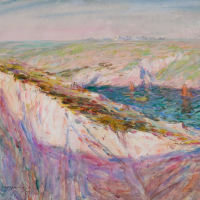26. JOHN PETER RUSSELL

John Peter Russell is also known as the Lost Impressionist, a name given to the Australian artist who moved to Europe in the early 1880s and enjoyed the height of Impressionism living in the cultural centre of the world. During his lifetime, his French landscapes did not enjoy the same renown of Arthur Streeton's (1867-1943) or Tom Roberts' (1856-1931) yet no other Australian artist gained the respect of so many giants of the art world. He was a student of the same atelier that produced Emile Bernard (1868-1948) and Toulouse Lautrec (1864-1901) and forged friendships with Van Gogh (1853-1890) and Rodin (1840-1917) Russell also painted with Monet (1840-1926) and taught colour theory to Matisse (1869-1954). In 1886 the artist moved with his wife, Marianna, to the island of Belle-ll, located off the coast of Brittany overlooking the Atlantic. He would remain here for the next twenty years, painting the ever-changing paysage maritimes of his beloved Cte Sauvage.
In addition to his oil paintings, Russell worked in the watercolour medium throughout his entire career, the immediacy suited his method of capturing his surroundings at a precise moment in time. Watercolour sketching became for Russell the perfect means with which to capture the transient physical beauty of changing seasons and climates.1 The present work, Cliffs at Goulphar Bay 1907 depicts the view from Port Goulphar, where Russell built the family home after relocating from Paris. Goulphar Bay is a slender body of water where, in summer, small sailing boats moor and in winter, ferocious storms lash the cliffs. This panorama is well-documented by Russell, the artist painted this view at various times of the day and in different seasons - during tempestuous storms and tranquil moments of calm. Cliffs at Goulphar Bay 1907 captures the artists impression of dazzling light on the rocky cliffs, known as Les Aiguilles (the needles) and the turquoise-hued Bay of Biscay. The high-keyed palette and loose paint handling seen in this example typify Russells oeuvre and are the hallmarks of the Impressionist painters of the early twentieth century. This current work was painted the year before the death of Marianna Russell in 1908 marking the end of the Belle-ll years. A devastated Russell left Belle-ll for Paris where he focused on raising his six children. He continued painting and sketching after he returned to Australia in 1921 however, as Ann Galbally notes, his best work was executed prior to his return to the southern hemisphere: Russell never re-captured that pleasing synthesis of chromatic intensity with reduction of form which had marked his best watercolour work.2
The Australian High commission in London staged an exhibition of Russells work in 1976 bringing overdue attention to the importance of his work in the context of Australian art history. The following year, the Melbourne dealer Joseph Brown held an exhibition of Russells work which attracted collectors eager to own work by our Lost Impressionist. The significance of his art has finally been realised and as such, its value has increased in line with demand. There has been growing interest in Russell's work in France, which is reflected in two exhibitions at the Muse des Jacobins at Morlaix in 1994 and 1997. The first volume of a two part study of Matisse by Frances Spurling, published in 1998, also underlines the critical role Russell played in Matisse's early development at Belle-ll in the 1880s. In 2018, a major retrospective of Russells work was staged at the Art Gallery of New South Wales, the first in forty years, bringing together 120 paintings, drawings and watercolours Cliffs at Goulphar Bay was amongst this important group of works which confirms John Peter Russells place within one of the most exhilarating periods in art history.
Footnotes
1.Galbally, A., The Art of John Peter Russell, Sun Books, Melbourne, 1977, p.79
2. ibid p.82
Caroline Jones MartAdmin.